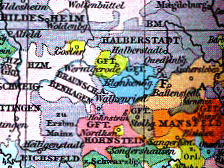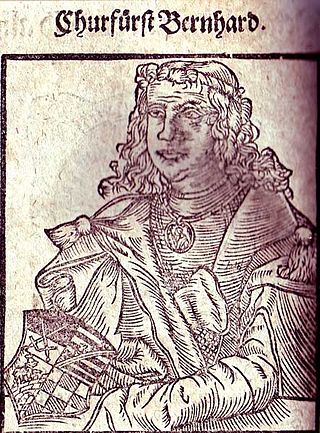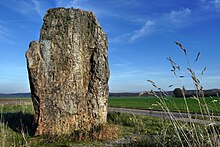
Quedlinburg is a town situated just north of the Harz mountains, in the district of Harz in the west of Saxony-Anhalt, Germany. As an influential and prosperous trading centre during the early Middle Ages, Quedlinburg became a center of influence under the Ottonian dynasty in the 10th and 11th centuries. The castle, church and old town with around 2,100 timber houses, dating from this time of influence, were added to the UNESCO World Heritage List in 1994 because of their exceptional preservation and outstanding Romanesque architecture.
Schachdorf Ströbeck is a village in Saxony-Anhalt, Germany, which since 1 January 2010 is part of the town of Halberstadt in the Harz district, in Saxony-Anhalt, Germany. Located about 8 km (5.0 mi) west of the city centre, the Schachdorf is known for its long historic connection with chess.

Gernrode is a historic town and former municipality in the Harz District, in Saxony-Anhalt, Germany. Since 1 January 2014, it has been part of Quedlinburg. It was the seat of the former Verwaltungsgemeinschaft of Gernrode/Harz.

Thale is a town in the Harz district in Saxony-Anhalt in central Germany. Located at the steep northeastern rim of the Harz mountain range, it is known for the scenic Bode Gorge stretching above the town centre.

Braunlage is a town and health resort in the Goslar district of Lower Saxony in Germany. Situated within the Harz mountain range, south of the Brocken massif, Braunlage's main business is tourism, particularly skiing. Nearby ski resorts include the Sonnenberg and the slopes on the Wurmberg.

Eastphalia is a historical region in northern Germany, encompassing the eastern Gaue (shires) of the historic stem duchy of Saxony, roughly confined by the River Leine in the west and the Elbe and Saale in the east. The territory corresponds with modern southeastern Lower Saxony, western Saxony-Anhalt, and northern Thuringia. Together with Westphalia, central Angria, and Nordalbingia, it was one of the four main Saxon administrative regions.
The Principality of Halberstadt was a state of the Holy Roman Empire ruled by Brandenburg-Prussia. It replaced the Bishopric of Halberstadt after its secularization in 1648. Its capital was Halberstadt. In 1807, the principality was made a state or regional capital of the Kingdom of Westphalia. In 1813, control of the principality was restored, and its sovereign rights were confirmed as the possession of the Kingdom of Prussia.

Blankenburg (Harz) is a town and health resort in the district of Harz in Saxony-Anhalt, Germany, at the north foot of the Harz Mountains, 12 miles (19 km) southwest of Halberstadt.

Falkenstein/Harz is a town in the Harz district, in Saxony-Anhalt, Germany. It was created in 2002 by merging the town of Ermsleben with the former municipalities of Endorf, Meisdorf, Neuplatendorf, Pansfelde, Reinstedt und Wieserode. The new community was named after Falkenstein Castle.

Elbingerode is an Ortsteil of Oberharz am Brocken in the Harz district, in the German state of Saxony-Anhalt. The former town was incorporated into the newly established municipality on 1 January 2010.
The County of Regenstein was a mediaeval statelet of the Holy Roman Empire. It was ruled by the Saxon comital House of Regenstein, named after their residence at Regenstein Castle near Blankenburg north of the Harz mountain range.

Quedlinburg Abbey was a house of secular canonesses (Frauenstift) in Quedlinburg in what is now Saxony-Anhalt, Germany. It was founded in 936 on the initiative of Saint Mathilda, the widow of the East Frankish King Henry the Fowler, as his memorial. For many centuries it and its abbesses enjoyed great prestige and influence. Quedlinburg Abbey was an Imperial Estate and one of the approximately forty self-ruling Imperial Abbeys of the Holy Roman Empire. It was disestablished in 1802/3. The church, known as Stiftskirche St Servatius, is now used by the Lutheran Evangelical Church in Germany.

The County of Blankenburg was a state of the Holy Roman Empire. Its capital was Blankenburg, it was located in and near the Harz mountains.

The County of Wernigerode was a state of the Holy Roman Empire which arose in the Harzgau region of the former Duchy of Saxony, at the northern foot of the Harz mountain range. The comital residence was at Wernigerode, now part of Saxony-Anhalt, Germany. The county was ruled by a branch of the House of Stolberg from 1429 until its mediatization to the Kingdom of Prussia in 1806. Nevertheless, the county remained in existence - with one short interruption - until the dissolution of the Kingdom of Prussia in 1918.

Bernhard, a member of the House of Ascania, was Count of Anhalt and Ballenstedt, and Lord of Bernburg through his paternal inheritance. From 1180 he was also Duke of Saxony.

Hessen, also Hessen am Fallstein, is a village in the Harz district of Saxony-Anhalt, Germany. Formerly part of the Aue-Fallstein municipal association, it was merged into the Osterwieck municipality on 1 January 2010.

Regenstein Castle is a ruined castle that lies three kilometres north of Blankenburg in the German state of Saxony-Anhalt. It is a popular tourist destination where, each year, a knight's tournament and a garrison festival are held.

Great Blankenburg Castle was built on the limestone hill of Blankenstein in the town of Blankenburg in the district of Harz in the German state of Saxony-Anhalt. Nearby is the Little Castle with its Baroque garden, tea house and museum, the town wall, the pheasant garden, the castle park and the castle pond.

the Regenstein family, also Reinstein, was a Lower Saxon noble family, which was named after the eponymous Regenstein Castle near Blankenburg on the edge of the Harz Mountains of central Germany.

The Halberstadt–Blankenburg railway is a non-electrified, single-track railway line, from Halberstadt via Langenstein and Börnecke to Blankenburg in the German state of Saxony-Anhalt. The Rübeland Railway connects to the line at Blankenburg (Harz) station. Until 1968, there was a branch to Derenburg. The branch line originally ran to Minsleben.























